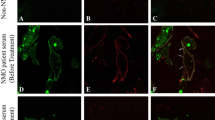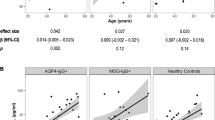Abstract
Neuromyelitis optica spectrum disorders (NMOSD) is a demyelinating autoimmune disease affecting the central nervous system causing inflammatory lesions in the optic nerves, spinal cord and other vital areas of CNS. The clinical manifestations include acute transverse myelitis with paraplegia and optic neuritis with impaired vision. In the present study we focussed on comparative expression of serum proteins between NMOSD variants and control. The study has identified a plethora of novel and unexplored acute phase proteins involved in lipid transport and myelination in perspective of NMOSD. The serum proteins obtained after albumin globulin depletion were subjected to LC–MS/MS. The commonly altered proteins in all NMOSD variants with respect to control were smaug homolog protein and serum amyloid A. Truncated breast and ovarian cancer susceptibility protein and cystic fibrosis transmembrane conductance regulator protein were specifically upregulated and can act as potential biomarkers for neuromyelitis optica with autoantibody negativity to Aquaporin – 4 (AQP-4) and myelin oligodendrocyte (MOG) immunoglobulins. In addition, the uniquely downregulated proteins such as antithrombin III and histidine rich glycoprotein in NMO/MOG autoantibody negative samples can be accounted for its dysregulated fibrinolysis associated with NMO. The differentially expressed proteins were involved in cholesterol transport, synaptic vesicle mediated transport, neurotransmission and immune regulation which are closely associated with myelin formation and protection.


Similar content being viewed by others
References
Jasiak-Zatonska M, Kalinowska-Lyszczarz A, Michalak S, Kozubski W. The Immunology of Neuromyelitis Optica—Current Knowledge, Clinical Implications, Controversies and Future Perspectives. Int J Mol Sci [Internet]. 2016 Mar 2 [cited 2021 Mar 22];17(3). Available from: https://www.ncbi.nlm.nih.gov/pmc/articles/PMC4813137/
Roy U, Satyanarayan Saini D, Pan K, Pandit A, Ganguly G, Panwar A. Frontiers | Neuromyelitis Optica Spectrum Disorder with Tumefactive Demyelination mimicking Multiple Sclerosis: A Rare Case | Neurology [Internet]. [cited 2021 Mar 22]. Available from: https://www.frontiersin.org/articles/https://doi.org/10.3389/fneur.2016.00073/full
Zarei S, Eggert J, Franqui-Dominguez L, Carl Y, Boria F, Stukova M, et al. Comprehensive review of neuromyelitis optica and clinical characteristics of neuromyelitis optica patients in Puerto Rico. Surg Neurol Int [Internet]. 2018 Dec 3 [cited 2021 Mar 22];9. Available from: https://www.ncbi.nlm.nih.gov/pmc/articles/PMC6293609/
Weinshenker BG, Wingerchuk DM. Neuromyelitis Spectrum Disorders. Mayo Clin Proc. 2017;92(4):663–79.
Hinson SR, Romero MF, Popescu BFGh, Lucchinetti CF, Fryer JP, Wolburg H, et al. Molecular outcomes of neuromyelitis optica (NMO)-IgG binding to aquaporin-4 in astrocytes. Proc Natl Acad Sci U S A. 2012;109(4):1245–50.
Chihara N, Aranami T, Sato W, Miyazaki Y, Miyake S, Okamoto T, et al. Interleukin 6 signaling promotes anti-aquaporin 4 autoantibody production from plasmablasts in neuromyelitis optica. Proc Natl Acad Sci U S A. 2011;108(9):3701–6.
Reindl M, Waters P. Myelin oligodendrocyte glycoprotein antibodies in neurological disease. Nat Rev Neurol. 2019;15(2):89–102.
Lennon VA, Wingerchuk DM, Kryzer TJ, Pittock SJ, Lucchinetti CF, Fujihara K, et al. A serum autoantibody marker of neuromyelitis optica: distinction from multiple sclerosis. Lancet Lond Engl. 2004;364(9451):2106–12.
Cheng C, Jiang Y, Chen X, Dai Y, Kang Z, Lu Z, et al. Clinical, radiographic characteristics and immunomodulating changes in neuromyelitis optica with extensive brain lesions. BMC Neurol. 2013;13(1):72.
Davoudi V, Keyhanian K, Bove RM, Chitnis T. Immunology of neuromyelitis optica during pregnancy. Neurol Neuroimmunol Neuroinflammation. 2016 Dec;3(6):e288.
Huang T, Long M, Huo B. Competitive Binding to Cuprous Ions of Protein and BCA in the Bicinchoninic Acid Protein Assay. Open Biomed Eng J. 2010;4:271–8.
Götz S, García-Gómez JM, Terol J, Williams TD, Nagaraj SH, Nueda MJ, et al. High-throughput functional annotation and data mining with the Blast2GO suite. Nucleic Acids Res. 2008;36(10):3420–35.
Shen C, Sun X-G, Liu N, Mu Y, Hong C-C, Wei W, et al. Increased serum amyloid A and its association with autoantibodies, acute phase reactants and disease activity in patients with rheumatoid arthritis. Mol Med Rep. 2015;11(2):1528–34.
Nejatbakhsh N, Feng Z. Calcium binding protein-mediated regulation of voltage-gated calcium channels linked to human diseases. Acta Pharmacol Sin. 2011;32(6):741–8.
Laragione T, Brenner M, Lahiri A, Gao E, Harris C, Gulko PS. Huntingtin-interacting protein 1 (HIP1) regulates arthritis severity and synovial fibroblast invasiveness by altering PDGFR and Rac1 signalling. Ann Rheum Dis. 2018;77(11):1627–35.
Pek SLT, Tavintharan S, Wang X, Lim SC, Woon K, Yeoh LY, et al. Elevation of a novel angiogenic factor, leucine-rich-α2-glycoprotein (LRG1), is associated with arterial stiffness, endothelial dysfunction, and peripheral arterial disease in patients with type 2 diabetes. J Clin Endocrinol Metab. 2015;100(4):1586–93.
He C, Liu C, Wang L, Sun Y, Jiang Y, Hao Y. Histone methyltransferase NSD2 regulates apoptosis and chemosensitivity in osteosarcoma. Cell Death Dis. 2019;10(2):1–13.
Ijsselstijn L, Dekker LJM, Stingl C, van der Weiden MM, Hofman A, Kros JM, et al. Serum levels of pregnancy zone protein are elevated in presymptomatic Alzheimer’s disease. J Proteome Res. 2011;10(11):4902–10.
Kastner S, Thiemann I-J, Dekomien G, Petrasch-Parwez E, Schreiber S, Akkad DA, et al. Exome Sequencing Reveals AGBL5 as Novel Candidate Gene and Additional Variants for Retinitis Pigmentosa in Five Turkish Families. Invest Ophthalmol Vis Sci. 2015;56(13):8045–53.
Plantone D, Inglese M, Salvetti M, Koudriavtseva T. A Perspective of Coagulation Dysfunction in Multiple Sclerosis and in Experimental Allergic Encephalomyelitis. Front Neurol [Internet]. 2019 [cited 2021 Mar 22];9. Available from: https://www.frontiersin.org/articles/https://doi.org/10.3389/fneur.2018.01175/full
Troldborg A, Steffensen R, Trendelenburg M, Hauser T, Winther KG, Hansen AG, et al. Ficolin-3 Deficiency Is Associated with Disease and an Increased Risk of Systemic Lupus Erythematosus. J Clin Immunol. 2019;39(4):421–9.
Ding H, Wu T. Insulin-Like Growth Factor Binding Proteins in Autoimmune Diseases. Front Endocrinol [Internet]. 2018 [cited 2021 Mar 22];9. Available from: https://www.frontiersin.org/articles/https://doi.org/10.3389/fendo.2018.00499/full
Dutta R, Chang A, Doud MK, Kidd GJ, Ribaudo MV, Young EA, et al. Demyelination causes synaptic alterations in hippocampi from multiple sclerosis patients. Ann Neurol. 2011;69(3):445–54.
Skerka C, Chen Q, Fremeaux-Bacchi V, Roumenina LT. Complement factor H related proteins (CFHRs). Mol Immunol. 2013;56(3):170–80.
Acknowledgements
This work was supported by Jubilee Centre for Medical Research. The authors gratefully acknowledged the contribution of Dr. D. M. Vasudevan, Dr. P. R. Varghese and Dr. P. C. Gilvaz for their encouragement and support. The authors highly appreciated and are grateful to Dr. Abdul Jaleel and Mr. Mahesh Chandran for the proteomics core facility support, at Rajiv Gandhi Centre for Biotechnology, Thiruvananthapuram.
Funding
The research funding for the study was provided by Jubilee Centre for Medical Research.
Author information
Authors and Affiliations
Contributions
MJ designed, conceptualized and initiated the experiments. EM executed the lab experiments and helped in compilation of the data. SD designed the bioinformatics experiments and helped in compilation of the data. HT did the diagnosis for the patients and helped in conceptualization of the study.
Corresponding author
Ethics declarations
Conflict of interest
The authors declare that there is no conflict of interest in the study.
Consent to participate
Consent was obtained from the participants in the study.
Consent for publication
Consent for publication was obtained in accordance with ethical guidelines.
Ethical approval
The study got approval from the Institutional Ethics Committee. IEC number: 86/19/IEC/JMMC & RI.
Additional information
Publisher's Note
Springer Nature remains neutral with regard to jurisdictional claims in published maps and institutional affiliations.
Supplementary Information
Below is the link to the electronic supplementary material.
Rights and permissions
About this article
Cite this article
John, M., Maria, E., Das, S. et al. Identification of Novel Serum Proteins Associated with Myelination and Cholesterol Transport in Neuromyelitis Optica Spectrum Disorders by Mass Spectrometry. Ind J Clin Biochem 37, 275–284 (2022). https://doi.org/10.1007/s12291-021-01004-w
Received:
Accepted:
Published:
Issue Date:
DOI: https://doi.org/10.1007/s12291-021-01004-w




